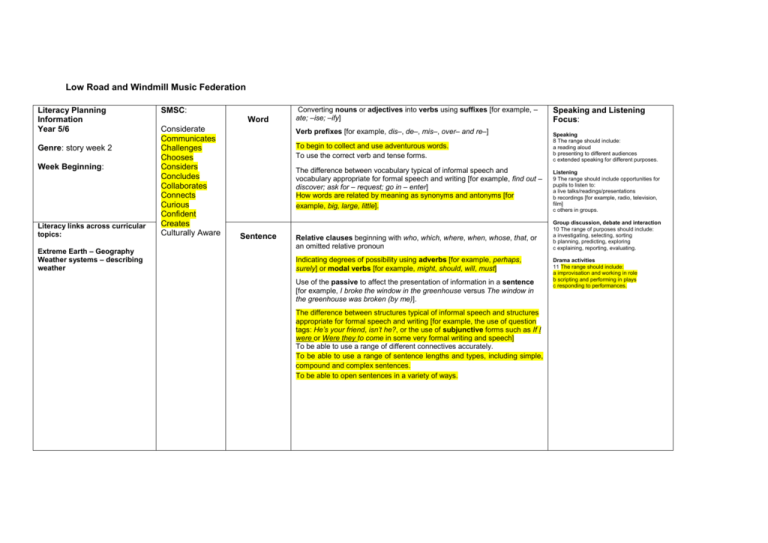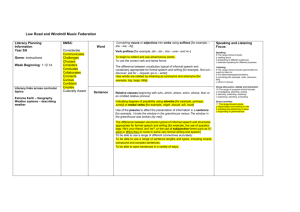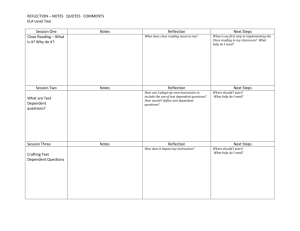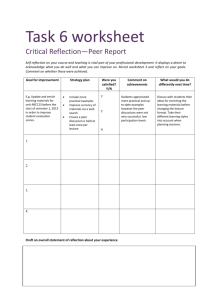Low Road and Windmill Music Federation
advertisement

Low Road and Windmill Music Federation Literacy Planning Information Year 5/6 Genre: story week 2 Week Beginning: Literacy links across curricular topics: Extreme Earth – Geography Weather systems – describing weather SMSC: Word Considerate Communicates Challenges Chooses Considers Concludes Collaborates Connects Curious Confident Creates Culturally Aware Converting nouns or adjectives into verbs using suffixes [for example, – ate; –ise; –ify] Verb prefixes [for example, dis–, de–, mis–, over– and re–] To begin to collect and use adventurous words. To use the correct verb and tense forms. The difference between vocabulary typical of informal speech and vocabulary appropriate for formal speech and writing [for example, find out – discover; ask for – request; go in – enter] How words are related by meaning as synonyms and antonyms [for example, big, large, little]. Sentence Relative clauses beginning with who, which, where, when, whose, that, or an omitted relative pronoun Indicating degrees of possibility using adverbs [for example, perhaps, surely] or modal verbs [for example, might, should, will, must] Use of the passive to affect the presentation of information in a sentence [for example, I broke the window in the greenhouse versus The window in the greenhouse was broken (by me)]. The difference between structures typical of informal speech and structures appropriate for formal speech and writing [for example, the use of question tags: He’s your friend, isn’t he?, or the use of subjunctive forms such as If I were or Were they to come in some very formal writing and speech] To be able to use a range of different connectives accurately. To be able to use a range of sentence lengths and types, including simple, compound and complex sentences. To be able to open sentences in a variety of ways. Speaking and Listening Focus: Speaking 8 The range should include: a reading aloud b presenting to different audiences c extended speaking for different purposes. Listening 9 The range should include opportunities for pupils to listen to: a live talks/readings/presentations b recordings [for example, radio, television, film] c others in groups. Group discussion, debate and interaction 10 The range of purposes should include: a investigating, selecting, sorting b planning, predicting, exploring c explaining, reporting, evaluating. Drama activities 11 The range should include: a improvisation and working in role b scripting and performing in plays c responding to performances. Group NC Levels, PP Children and More Able (MA): Text MA group 1 Alysha Kenzi pp Kyle pp Levi pp Cody pp Devices to build cohesion within a paragraph [for example, then, after that, this, firstly] Spelling Focus: Linking ideas across paragraphs using a wider range of cohesive devices: repetition of a word or phrase, grammatical connections [for example, the use of adverbials such as on the other hand, in contrast, or as a consequence], and ellipsis ough Layout devices [for example, headings, sub-headings, columns, bullets, or tables, to structure text] To make sure that the audience and purpose of my writing is clear. To be able to create a clear picture in the reader’s mind using elaborate descriptive and technical vocabulary. Group 2 Harry Connor pp Keigan pp Kian pp Lennon pp Lily pp Brackets, dashes or commas to indicate parenthesis Punctuation Use of commas to clarify meaning or avoid ambiguity To use speech marks to denote speech, and begin to use some other speech punctuation. Group 3 Chloe pp Esmenia Summer pp Tia pp Mohamed Bradley pp Learning Objective Connection/ Introduction Activation Teaching Learning To use inverted commas to punctuate direct speech Re visit writing plan and objectives and where we are up to with the story Children to work in three groups all with adult support Reflection Session 1: Recap story plan Read and analyse children’s opening paragraph Homework: To find an image of a building the characters need to take shelter in and create a word bank Demonstration into shared writing Reflection Refer to plan – next section In the woods with friends, storm breaks, need to find shelter Focus on dialogue between the 2 characters and how you can give away information about their personalities All groups to write the description of the outside of the shelter What effect has the author created? How have they done this? Look at the vocabulary, simile etc Demonstration into shared writing Use of figurative language to create an Effect Repeat at end of session but focus on the inside of the building Homework: Explain assessment task – show planning sheet Children to look at door and plan what may be inside Reflection To use figurative language Synonyms Simile Alliteration repetition Reflection Session 2: Review Harwell Hall teach how to use inverted commas to punctuate direct speech and by what and how they say things you can give clues Read the Description of Harwell Hall Session 3: Assessed writing task It’s a mystery Review the assessed writing task Review homework Show children some egs of children’s work and mark scheme Assessed writing task Generate a list of key features to include Homework: Speaking and listening / drama Reflection Look at the door Hot seat Ali Generate a list of Q to ask character, paired talk into freeze frames, conscience ally, hot seating Planning time Session 4: Reflection Homework: Session 5: Reflection Homework:





